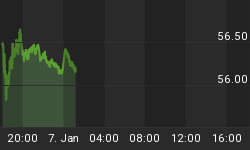Although China is not the biggest economy in the world by GDP, (it is third, after growing a remarkable 8.7 percent last year), its exports are increasingly seen as the needed lifeline for many shaky economies. But as China plots its future as the world's largest exporter, it must be of some concern to them that their top two clients (the US and EU) are broke. As a result, China knows that it will have to look beyond developed markets for continued growth.
While a rebalancing of the Chinese economy towards domestic consumption is increasingly evident, the Chinese are also aggressively focusing investments toward emerging markets. By securing precious natural resources, developing infrastructure and deepening trade relations with the developing world, the Chinese are lessening their economic dependence on the mature markets of the US and EU.
In the developing world, China's influence is hard to miss. Direct trade agreements with Brazil (China is its largest trade partner) and Argentina reflect its growing influence in South America, long considered the United States' sphere of influence. Africa has experienced influx of Chinese investment, with resource-for-development contracts being signed with several African countries. Unlike the West, China rarely let's other interests trump commerce. China has concluded agreements with international pariah states like Sudan, Iran and Venezuela. The warm welcome these countries receive in Beijing stands in sharp contrast to the reception many Chinese companies have received on American shores - just ask CNOOC.
But nowhere is China's growing influence felt more than in its own backyard.
Last week, a landmark Economic Cooperation Framework Agreement with Taiwan was signed. The agreement cuts or eliminates tariffs on billions of dollars of Taiwanese imports and, almost as importantly, opens the door for other Asian countries to sign trade agreements with Taiwan without fear of drawing China's ire. Given the long shadow cast by the strengthening mainland, some in Taiwan have characterized the treaty as a "matter of economic life or death." This is perhaps a bit melodramatic, but such is the perceived importance of being competitive in China.
To China's south, the ten member block of emerging- and frontier-market countries known as the Association of Southeast Asian Nations (ASEAN) have seen economic ties with China strengthen greatly over the past decade. In January of this year, the much anticipated China-ASEAN Free Trade Agreement was launched, covering nearly two billion people and $250 billion in trade flows in 2008 alone. ASEAN has 580 million potential consumers of Chinese exports, and a combined economy bigger than that of India. Substantial reserves of resources such as oil, natural gas, coal, and other commodities are of keen interest to resource-hungry China. New infrastructure development will be needed to access all of those resources, and the Chinese are always happy to help.
In Vietnam, for example, Chinese firms hold a third of ongoing construction projects - including railways, ports, and power plants. Bilateral trade between China and ASEAN is expected to surpass that between the US and ASEAN by the end of 2012, a growth of over 50% from current levels. According to conservative estimates from the Financial Times' China Confidential newsletter, direct investment from Chinese companies into ASEAN may climb to a cumulative $30bn by the end of 2012, increasing nearly five-fold from the cumulative $6.5bn at year-end 2008.
Much of this push into ASEAN is motivated by the rising cost structures Chinese firms are facing at home. Domestic labor shortages and strikes are leading to rising wages, and likely to RMB appreciation. Though this is a sign of the increasing wealth of the Chinese, some low-cost manufacturers may move to receptive ASEAN countries, which are now lower on the economic ladder. Industrial business parks are sprouting up across Southeast Asia to accommodate the trend.
In what should be a familiar refrain for those here in the US, Chinese businesses are looking to move "south of the border" to remain competitive. An unintended benefit of these new investment flows will likely be an increasing acceptance of the RMB in ASEAN states as a stable and strengthening currency. The Chinese intend for the RMB to become ASEAN's trade settlement currency of choice, replacing the precarious US dollar. This may form the bridgehead from which the RMB establishes itself as a truly international reserve currency.
For investors, the Chinese push into frontier markets may offer promising returns in the medium-term. For example, emerging market bonds have rallied every quarter since the end of 2008, and posted record inflows this year. [Past performance does not guarantee future results.] Unfortunately, accessing frontier markets has historically been difficult for small investors. Poor accounting practices, corruption, lack of local knowledge, and illiquidity are risks to be considered.
For the right investor, though, there are increasing opportunities to invest in these markets via enterprising Chinese firms. Exchanges in Hong Kong, Singapore, Australia, and even Canada are now home to Chinese companies investing or operating in ASEAN member countries. Today, these historically remote markets are no longer the exclusive domain of hedge funds, institutions, and private equity investors. Any investor seeking to capitalize on growth in Asia can now look beyond China and toward the emerging ASEAN economies formerly in the shadow of the dragon.
For in-depth analysis of this and other investment topics, subscribe to The Global Investor, Peter Schiff's free newsletter. Click here for more information.
Click here for a description of Peter Schiff's best-selling, just-released book, How an Economy Grows and Why It Crashes.
John Downs is the Assistant Manager of the Los Angeles branch of Euro Pacific Capital. During a ten-week stint in China and Southeast Asia earlier this year, John got to witness Asia's economic vibrancy firsthand and has brought home a new appreciation for emerging economies. He holds degrees in History and Political Science from the University of California at Davis.
Please note: Opinions expressed are those of the writer.















